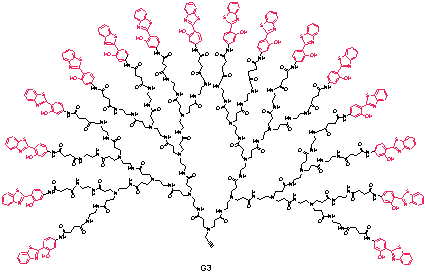| [1] Bosman, A. W.; Janssen, H. M.; Meijer, E. W. Chem. Rev. 1999, 99, 1665. [2] Grayson, S. M.; Frechet, J. M. J. Chem. Rev. 2001, 101, 3819. [3] Smith, D. K.; Hirst, A. R.; Love, C. S.; Hardy, J. G.; Brignell, S. V.; Huang, B. Q. Prog. Polym. Sci. 2005, 30, 220. [4] Zeng, Y.; Li, Y. Y.; Li, M.; Yang, G. Q.; Li, Y. J. Am. Chem. Soc. 2009, 131, 9100. [5] Tekade, R. K.; Kumar, P. V.; Jain, N. K. Chem. Rev. 2009, 109, 49. [6] Kikkeri, R.; Garcia-Rubio, I.; Seeberger, P. H. Chem. Commun. 2009, 235. [7] Yuan, Z.; Chen, J. P.; Zeng, Y.; Li, Y. Y.; Han, Y. B.; Li, Y. Org. Biomol. Chem. 2011, 9, 6256. [8] Yuan, Z.; Zheng, S. J.; Zeng, Y.; Chen, J. P.; Han, Y. B.; Li, Y. Y.; Li, Y. New J. Chem. 2010, 34, 718. [9] Zou, J. H.; Wu, H.; Lam, C. S.; Wang, C. D.; Zhu, J.; Zhong, C. M.; Hu, S. J.; Ho, C. L.; Zhou, G. J.; Wu, H. B.; Choy, W. C. H.; Peng, J. B.; Cao, Y.; Wong, W. Y. Adv. Mater. 2011, 23, 2976. [10] Lo, S. C.; Burn, P. L. Chem. Rev. 2007, 107, 1097. [11] Zeng, Y.; Li, Y. Y.; Chen, J. P.; Yang, G. Q.; Li, Y. Chem. Asian J. 2010, 5, 992. [12] Kwon, J. E.; Park, S. Y. Adv. Mater. 2011, 23, 3615. [13] Li, S. Y.; He, L. M.; Xiong, F.; Li, Y.; Yang, G. Q. J. Phys. Chem. B 2004, 108, 10887. [14] Lv, F. T.; Gao, L. N.; Fang, Y. Prog. Chem. 2005, 17, 773. (吕凤婷, 高莉宁, 房喻, 化学进展, 2005, 17, 773.)[15] Qian, Y.; Li, S. Y.; Zhang, G. Q.; Wang, Q.; Wang, S. Q.; Xu, H. J.; Li, C. Z.; Li, Y.; Yang, G. Q. J. Phys. Chem. B 2007, 111, 5861. [16] Park, S.; Kwon, J. E.; Kim, S. H.; Seo, J.; Chung, K.; Park, S.-Y.; Jang, D.-J.; Medina, B. M.; Gierschner, J.; Park, S. Y. J. Am. Chem. Soc. 2009, 131, 14043. [17] Hu, R.; Feng, J. A.; Hu, D. H.; Wang, S. Q.; Li, S. Y.; Li, Y.; Yang, G. Q. Angew. Chem., Int. Ed. 2010, 49, 4915. [18] Qian, Y.; Cai, M. M.; Xie, L. H.; Huang, W. Acta Chim. Sinica 2010, 68, 2285. (钱妍, 蔡敏敏, 解令海, 黄维, 化学学报, 2010, 68, 2285.)[19] Tang, K. C.; Chang, M. J.; Lin, T. Y.; Pan, H. A.; Fang, T. C.; Chen, K. Y.; Hung, W. Y.; Hsu, Y. H.; Chou, P. T. J. Am. Chem. Soc. 2011, 133, 17738. [20] Schenning, A. P. H. J.; Elissen-Roman, C.; Weener, J. W.; Baars, M. W. P. L.; van der Gaast, S. J.; Meijer, E. W. J. Am. Chem. Soc. 1998, 120, 8199. [21] Wang, B. B.; Zhang, X.; Jia, X. R.; Li, Z. C.; Ji, Y.; Yang, L.; Wei, Y. J. Am. Chem. Soc. 2004, 126, 15180. [22] Hu, R.; Li, S. Y.; Zeng, Y.; Chen, J. P.; Wang, S. Q.; Li, Y.; Yang, G. Q. Phys. Chem. Chem. Phys. 2011, 13, 2044. Tomalia, D. A.; Baker, H.; Dewald, J.; Hall, M. E.; Kallos, G.; Martin, S.; Roeck, J.; Ryder, J.; Smith, P. Polym. J. 1985, 17, 117. |
